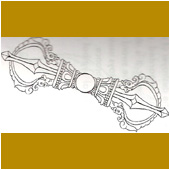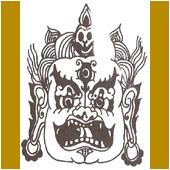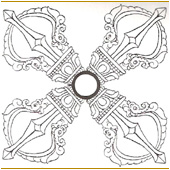
V
Vajra
Thunderbolt or diamond implying indestructibility. Principal symbol of Vajrayana
Buddhism representing absolute truth, In Hinduism, the thunderbolt is wielded
by several gods, including Indra.
This thunderbolt originally was the symbol of the Vedic god Indra: it represents lightning.
Among the Buddhists it is the symbol of the imperturbable male principle, which stands for the upaya or method or path. There are five points that symbolize the five jivas or conquerors-the five Dhyani Buddhas.
In Tibetan the vajra is know as the Dorje, a tantric symbol for the absolute, beyond all opposites, and represents the three jewels, and also the union of the spiritual and the material world. Among the Tibetans it is also a symbol of unity and strength.
 |
Vardhamana
Founder of the Jain religion later know as Mahavir, the great hero. He was born
into a royal family probably in 599 B.C.E. in the same region of North India
as the Buddha. He traveled and preached for thirty years and died at the age
of seventy-two, in 527 B.C.E.
Vanaspati
This is the mask. It is pre-Vedic. It is called vanaspati, a personification of the divine presence. It displays the illusion but hides the real.
It is also pre-Buddhist. Apparently there had been widespread worship to the devil or fire, which must have found its way to Tibet. In Tibet Bon-po, the worship of the demon was prevalent unitl the introduction of Buddhism. The mask here represents both the good and bad sides of a deity. Among the Tibetans the fire ritual represents purification.
The kirtimukha is a mystic mask that means the ‘Face of Glory’ but it has generally grotesque aspects, ferocious and terrifying. It is diabolical and is meant to frighten the devil himself. The fierce deities are regarded as the guardians of the Buddha.

Varman
"Protected by." A title used by various rulers, particularly Khmer kings.
Varna
Class or caste. The four castes of Hinduism are: Brahman, the learned class;
Kshatriya, the royal or warrior class; Vaishya, the trading
Vat
Temple, in Khmer.
Veda
"Knowledge." Refers to a collection of very ancient hymns and verses sacred
to Hinduism. The earliest was composed between 1500 and 1200 B.C.E. There art
four Vedas: Rig, Sama, Yajur, and Atharva.
Visvavajra
This is a double thunderbolt. It symbolizes the conclusion of all actions; it also represents the Absolute as being everywhere, omnipresent.
In Tibetan it stands for the Wheel of the Good Law; it is indestructible.
In Tantra it designates sunya – void – which cannot be cut or destroyed, but which destroys all evil. It is the emblem of Amaghasiddhi.

Vitarkamudra
A hand gesture of the Buddha indicating exposition. The right arm is bent, the
index or ring finger touching the thumb, palm outward. Sometimes seen with both
hands performing the same gesture.
Votive tablet
A religious tablet or plaque made to express a with or prayer, or made to express
the fulfillment of a vow.